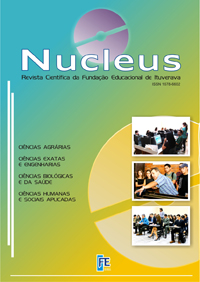PHYSIOLOGIC QUALITY OF BEAN SEEDS IN FUNCTION OF THE PLANTS POPULATION AND NITROGEN IN NO TILL
DOI:
https://doi.org/10.3738/nucleus.v5i2.121Keywords:
Phaseolus vulgaris, adubação nitrogenada, espaçamento entrelinha, vigorAbstract
The first factor to be observed in the establishment of a farming is the seeds quality, factor that can be influenced by the nitrogen fertilization. Thus, with the objective of evaluating the physiologic quality of bean seeds in function of three plants populations and sowing or sidedressing nitrogen fertilization, was carried an experiment in a Typic Acrustox in randomized blocks design with four replications in factorial scheme 3x2x5, being, three plants populations (200, 240 and 300 thousand plants for hectare), two N rates in sowing (10 and 20 kg / there is) and five sidedressing N rates (0, 25, 50, 75 and 100 kg / there is). The following evaluations were accomplished: standard germination test, first counting, germination speed index, accelerated aging and electric conductivity. Smaller plants populations provide better physiologic quality of the seeds, because they present seeds with larger vigor, evidenced through the accelerated aging test. The sowing or sidedressing application does not interfere in the physiologic quality of the bean.Downloads
Published
2008-11-27
Issue
Section
Articles
License
À revista se reserva o direito de efetuar, nos originais, alterações de ordem normativa, ortográfica e gramatical, com vistas a manter o padrão culto da língua, respeitando, porém, o estilo dos autores. A provas finais não serão obrigatoriamente enviadas aos autores. Os trabalhos publicados passam a ser propriedade da revista. As opiniões emitidas pelos autores dos artigos são de sua exclusiva responsabilidade.How to Cite
PHYSIOLOGIC QUALITY OF BEAN SEEDS IN FUNCTION OF THE PLANTS POPULATION AND NITROGEN IN NO TILL. (2008). Nucleus, 5(2). https://doi.org/10.3738/nucleus.v5i2.121


